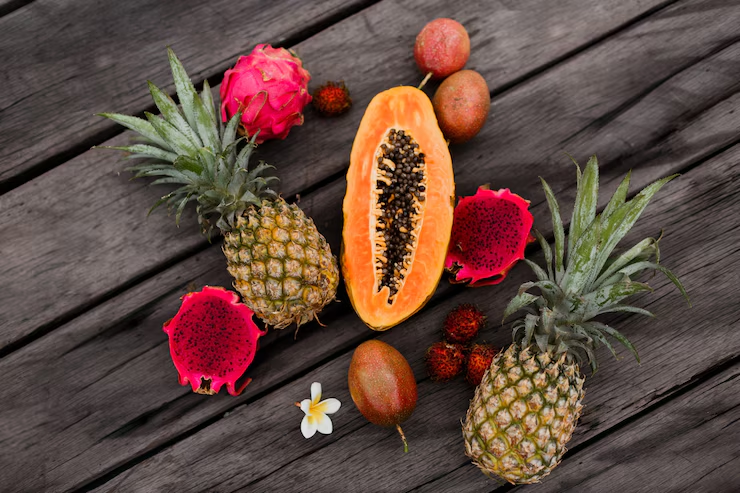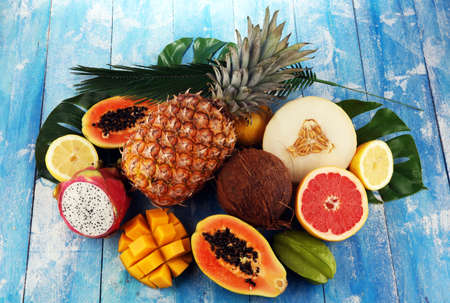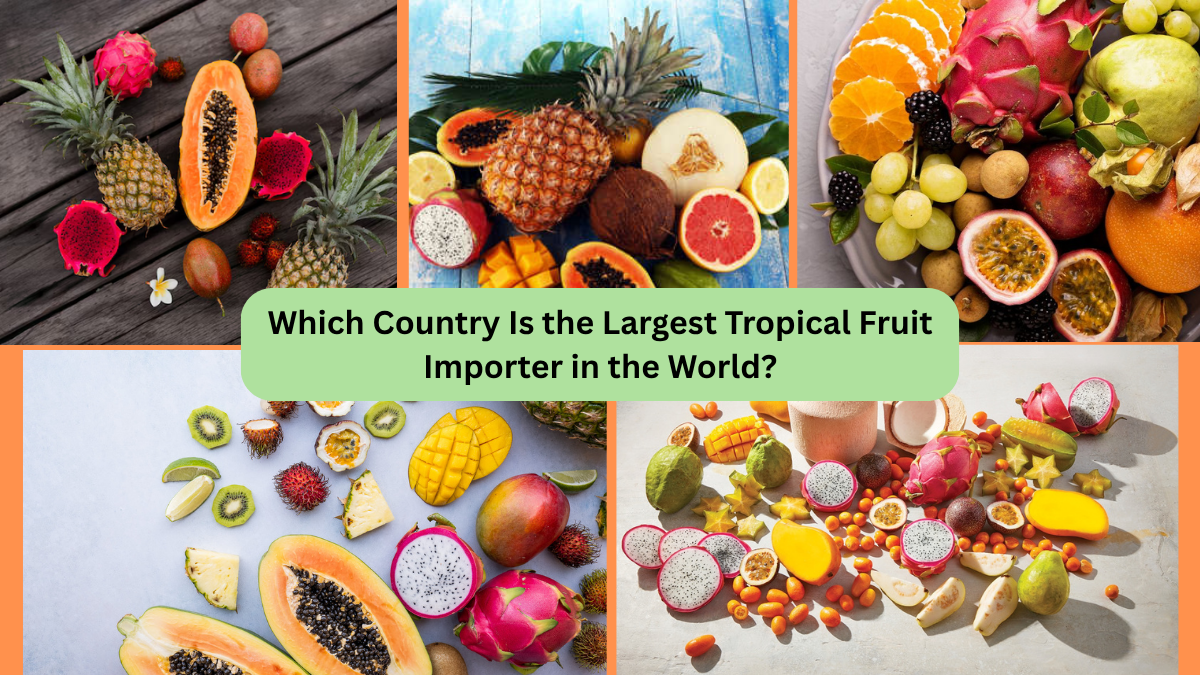Tropical fruits have long been valued for their vibrant flavors, exotic appeal, and abundant health benefits. From juicy mangoes and fragrant pineapples to rich avocados and prized durians, these fruits play an essential role in global culinary culture. While tropical fruit cultivation is centered in warm, humid regions, demand for these fruits has spread far beyond their native climates — making them a sought-after commodity worldwide.
But which country imports the most tropical fruits? The answer may surprise you. In this article, we’ll explore the dynamics of the global tropical fruit trade, identify the world’s largest importer, and uncover the reasons behind its growing appetite for these colorful, nutrient-packed delicacies.
Global Tropical Fruit Market Overview

The global tropical fruit market is one of the fastest-growing segments in international agricultural trade. According to the Food and Agriculture Organization (FAO) and recent international trade reports, tropical fruit exports have grown consistently over the past decade, driven by rising health awareness, exotic culinary trends, and international food trade expansion.
Some of the most commercially significant tropical fruits include:
- Bananas
- Mangoes
- Pineapples
- Avocados
- Papayas
- Durians
- Mangosteens
- Guavas
- Passionfruits
- Coconuts
While tropical fruits are cultivated across Asia, Central and South America, and Africa, their consumption is now global — with countries importing these fruits for both fresh produce markets and processed food industries.
China: The World’s Largest Tropical Fruit Importer
Key Data:
- Tropical fruit import volume (2023): Over 7.5 million metric tons
- Import value: Approximately USD 16.85 billion
- Top imported tropical fruits: Durians, bananas, mangosteens, coconuts, pineapples
China has officially surpassed all other nations as the world’s largest importer of tropical fruits. In recent years, the country’s growing middle class, urbanization, and changing dietary preferences have driven an insatiable appetite for tropical fruits — particularly high-end, luxury varieties like durians and mangosteens.
Why Is China Leading the Market?
- Rising Incomes and Middle-Class Expansion:
As China’s economy has grown, so has its middle class. With more disposable income, Chinese consumers are increasingly willing to spend on premium, exotic, and imported fruits. - Cultural Preferences for Exotic and Symbolic Fruits:
In Chinese culture, fruits like durians and mangosteens are symbols of prosperity and luxury, often presented as gifts or served at special occasions. - Health and Wellness Trends:
The rising popularity of nutrient-dense, antioxidant-rich tropical fruits aligns with modern health trends in China, especially post-pandemic. - Year-Round Demand and Seasonal Imports:
China’s domestic climate isn’t suitable for many tropical fruits, especially during winter months. Imports fill this seasonal gap. - Diversification of Suppliers:
China imports tropical fruits from Thailand, Vietnam, the Philippines, Ecuador, Indonesia, and other regions, ensuring a continuous and varied supply.
Major Tropical Fruits Imported by China

Durians
China is the world’s largest durian market, importing over USD 6.7 billion worth in 2023 alone. Fresh and frozen durians, especially from Thailand and Vietnam, are highly prized and consumed as luxury desserts.
Bananas
Bananas remain a staple in China, with imports exceeding 1.7 million metric tons annually. The Philippines and Ecuador are the top suppliers.
Coconuts
Fresh, young, and dried coconuts are increasingly popular, with imports exceeding 1.18 million metric tons.
Mangosteens and Mangoes
Mangosteens have carved out a luxury fruit market niche, while mangoes enjoy widespread popularity, especially in smoothies and desserts.
Other Leading Tropical Fruit Importers
While China leads the global tropical fruit import market, other nations also rank among the top importers:
| Country | Import Volume (2023) | Notable Details |
|---|---|---|
| United States | 5.2 million tons | Top importer of mangoes, avocados, bananas |
| European Union (as a bloc) | 4.9 million tons | Strong demand for pineapples, avocados, mangoes |
| Japan | 1.4 million tons | High per-capita tropical fruit consumption |
| Russia | 1.2 million tons | Heavy imports of bananas and pineapples |
| Canada | 900,000 tons | Increasing avocado and mango imports |
The United States and EU have long been major importers of tropical fruits, driven by diverse populations, strong retail networks, and health-focused consumers.
Where Do These Fruits Come From?

The world’s tropical fruit supply is concentrated in several key exporting countries:
- Mexico: Leading global exporter of mangoes and avocados.
- Ecuador: Top banana exporter worldwide.
- Thailand: Famous for high-quality durians and mangosteens.
- Philippines: A major supplier of bananas, pineapples, and mangoes.
- Vietnam: Rapidly growing durian and dragon fruit exporter.
- Peru and Colombia: Rising avocado exporters.
These countries play a vital role in meeting the growing international demand for tropical fruits.
The Economic and Cultural Value of Tropical Fruit Trade
The international trade of tropical fruits is more than just commerce — it also impacts livelihoods, cultural exchange, and sustainability. Millions of small farmers depend on tropical fruit cultivation for their incomes. Meanwhile, urban populations in importing countries benefit from access to healthy, diverse produce.
The tropical fruit trade also brings culinary traditions from one culture to another. In recent years, tropical fruits have found their way into everything from American smoothie bowls to European fine dining.
Tropical Fruit Market Trends and Future Outlook

Several market trends are shaping the future of global tropical fruit imports:
- Rising Demand for Superfruits
Fruits like avocados, dragon fruit, passionfruit, and durians are becoming increasingly trendy in global wellness culture. - Frozen and Processed Tropical Fruits
Demand for frozen mangoes, coconut water, and packaged pineapple products is rising, providing year-round availability and convenience. - Organic and Fair-Trade Produce
Health- and ethics-conscious consumers in the U.S. and Europe are willing to pay a premium for sustainably grown, organic tropical fruits. - Climate Challenges and Supply Diversification
As climate change affects traditional growing regions, new countries like Ghana, Côte d’Ivoire, and Cambodia are emerging as alternative suppliers. - Continued Chinese Market Growth
Given the rising middle class and cultural significance of exotic fruits, China’s tropical fruit import market is projected to grow by 8–10% annually over the next five years.
Final Thoughts

In the global race for tropical fruit imports, China stands firmly at the top, importing over 7.5 million metric tons worth nearly USD 17 billion annually. Its appetite for tropical fruits — led by durians, bananas, mangosteens, and coconuts — far exceeds that of other nations. Following closely behind are the United States, the European Union, Japan, and Russia.
As health trends evolve, new varieties gain popularity, and climate challenges reshape supply chains, the global tropical fruit market is poised for even greater growth. With tropical fruits now a staple in kitchens from Beijing to Berlin, their importance in both trade and culture continues to expand.



